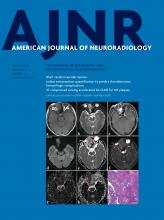Abstract
BACKGROUND AND PURPOSE: Loss of hemodynamic reserve in intracranial cerebrovascular disease reduces blood oxygenation level–dependent activation by fMRI and increases asymmetry in MTT measured by provocative DSC perfusion MR imaging before and after vasodilation with intravenous acetazolamide. The concordance for detecting hemodynamic reserve integrity has been compared.
MATERIALS AND METHODS: Patients (n = 40) with intracranial cerebrovascular disease and technically adequate DSA, fMRI and provocative DSC perfusion studies were retrospectively grouped into single vessels proximal to and distal from the circle of Willis, multiple vessels, and Moyamoya disease. The vascular territories were classified as having compromised hemodynamic reserve if the expected fMRI blood oxygenation level–dependent activation was absent or if MTT showed increased asymmetry following vasodilation. Concordance was examined in compromised and uncompromised vascular territories of each group with the Fischer exact test and proportions of agreement.
RESULTS: Extensive leptomeningeal collateral circulation was present in all cases. Decreased concordance between the methods was found in vascular territories with stenosis distal to but not proximal to the circle of Willis. Multivessel and Moyamoya diseases also showed low concordance. A model of multiple temporally displaced arterial inputs from leptomeningeal collateral flow demonstrated that the resultant lengthening MTT mimicked compromised hemodynamic reserve despite being sufficient to support blood oxygenation level–dependent contrast.
CONCLUSIONS: Decreased concordance between the 2 methods for assessment of hemodynamic reserve for vascular disease distal to the circle of Willis is posited to be due to well-developed leptomeningeal collateral circulation providing multiple temporally displaced arterial input functions that bias the perfusion analysis toward hemodynamic reserve compromise while blood oxygenation level–dependent activation remains detectable.
ABBREVIATIONS:
- ACA
- anterior cerebral artery
- AIF
- arterial input function
- BOLD
- blood oxygenation level–dependent
- CVD
- cerebrovascular disease
- HR
- hemodynamic reserve
- LCC
- leptomeningeal collateral circulation
- MMD
- Moyamoya disease
- MVD
- multivessel disease
- PCA
- posterior cerebral artery
- poa
- proportions of agreement
- sMCA
- superior division of middle cerebral artery
- SVDd
- single-vessel disease distal to the circle of Willis
- SVDp
- single-vessel disease proximal to the circle of Willis
- © 2018 by American Journal of Neuroradiology
Indicates open access to non-subscribers at www.ajnr.org












